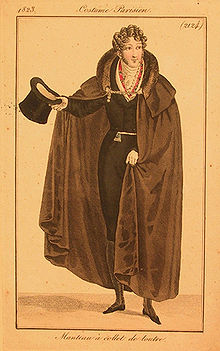Cloak


A cloak is a type of loose
Cloaks generally fasten at the neck or over the shoulder, and vary in length from the hip all the way down to the ankle – mid-calf being the normal length. They may have an attached hood and may cover and fasten down the front, in which case they have holes or slits for the hands to pass through. However, cloaks are almost always sleeveless.
Christian
Etymology
The word cloak comes from Old North French cloque (Old French cloche, cloke) meaning "travelling cloak", from Medieval Latin clocca "travelers' cape," literally "a bell," so called from the garment's bell-like shape. Thus the word is related to the word clock.[4]
History
Ancient Greeks and Romans were known to wear cloaks. Greek men and women wore the himation, from the Archaic through the Hellenistic periods (c. 750–30 BC).[5] Romans would later wear the Greek-styled cloak, the pallium. The pallium was quadrangular, shaped like a square,[6] and sat on the shoulders, not unlike the himation.
Romans of the Republic would wear the toga as a formal display of their citizenship. It was denied to foreigners[7] and was worn by magistrates on all occasions as a badge of office. The toga allegedly originated with Numa Pompilius (r. 715–672 BC), the second semi-legendary king of Rome.[8]
Eminent personages in Kievan Rus' adopted the Byzantine chlamys in the form of a fur-lined korzno[9] (
Powerful noblemen and elite warriors of the
Opera cloak
In full
Ladies may wear a long (over the shoulders or to ankles) cloak usually called a cape, or a full-length cloak. Gentlemen wear an ankle-length or full-length cloak. Formal cloaks often have expensive, colored linings and trimmings such as silk, satin, velvet and fur.
The term was the title of a 1942 operatic comedy.[12]
In literature and the arts

According to the King James Version of the Bible, Matthew recorded Jesus of Galilee saying in Matthew 5:40: "And if any man will sue thee at the law, and take away thy coat, let him have thy cloke also." The King James Version of the Bible has the words recorded a little differently in Luke 6:29: "...and him that taketh away thy cloke, forbid not to take thy coat also."
Cloaks are a staple garment in the
Fantasy cloaks are often
Metaphor
Figuratively, a cloak may be anything that disguises or conceals something. In many science fiction franchises, such as
Because they keep a person hidden and conceal a weapon, the phrase
See also
- Kinsale cloak
- Mantle (clothing)
- Poncho
- Robe
- Serape
- Shawl
- Shroud
- Stole (shawl)
- Spanish cloak
- Veil
- Witzchoura
- Wrap (clothing)
References
- ^ Bernadine Morris (March 31, 1981). "Italian fashion's success: a fresh point of view". The New York Times.
a simple wrap .. extra layer of protection from the elements
- ^ Bess Liebenson (February 24, 1991). "Changing Shapes of Clothes: Little for Men, Lots for Women". The New York Times.
- ^ "cappa". Oxford English Dictionary (Online ed.). Oxford University Press. (Subscription or participating institution membership required.)
- ^ "cloak – Origin and meaning of cloak by Online Etymology Dictionary". www.etymonline.com.
- ^ "Himation – clothing".
- ^ Tertullian, De Pallio, I
- ^ Suetonius, Divus Claudius, XV
- ^ William Smith, LLD; William Wayte; G. E. Marindin, eds. (1890). "Toga". A Dictionary of Greek and Roman Antiquities. London: John Murray.
- ^
Stamerov, K. (1986). History of Ukrainian Costume: From the Scythian Period to the Late 17th Century. Ukrainian heritage library. Melbourne, Victoria: Bayda Books. p. 21. ISBN 9780908480166. Retrieved 30 August 2023.) on the right shoulder.
The prince's korzno cloak [...] was an exact copy of the Byzantine chlamys of a rectangular or semicircular cut. It was thrown over the left shoulder and fixed with a brooch (fibula
- ^ корзно in Vasmer's Etymological Dictionary
- ^ "Ancient Aztec clothing". www.aztec-history.com. Retrieved 18 April 2021.
- ^ Olin Downes (November 4, 1942). "Double Bill Given by the New Opera: Damrosch's 'The Opera Cloak' Offered as Part of Program at Broadway Theatre". The New York Times. p. 26.
Damrosch's operatic comedy, "The Opera Cloak"
- ^ John Schwartz (October 20, 2006). "Scientists Take Step Toward Invisibility". The New York Times.
- ^ Philip Taubman (May 19, 1996). "Cloak and Dagger". The New York Times.
- ^ "Cloak & Dagger". The New York Times. June 6, 2018.
... the comics company's .. live-action series
Sources
- Oxford English Dictionary
- Ashelford, Jane: The Art of Dress: Clothing and Society 1500–1914, Abrams, 1996. ISBN 0-8109-6317-5
- Baumgarten, Linda: What Clothes Reveal: The Language of Clothing in Colonial and Federal America, ISBN 0-300-09580-5
- Payne, Blanche: History of Costume from the Stone Age to the Twentysecond Century, Harper & Row, 2965. No ISBN for this edition; ASIN B0006BMNFS
- Picken, Mary Brooks: The Fashion Dictionary, Funk and Bagnalls, 1957. (1973 edition ISBN 0-308-10052-2)
